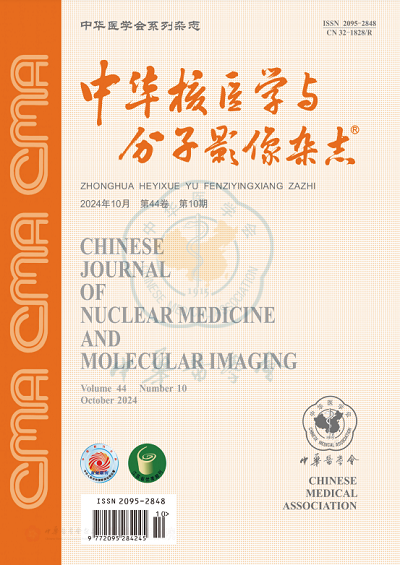Value of visual analysis and SUVR during 18F-AV45 PET/CT imaging in the diagnosis of mild cognitive impairment and Alzheimer′s disease
引用次数: 0
Abstract
Objective To evaluate the value of visual analysis and standardized uptake value ratio (SUVR) during 18F-florbetapir (AV45) PET/CT brain imaging in diagnosis of β-amyloid (Aβ) deposition in patients with mild cognitive impairment (MCI) and Alzheimer′s disease (AD), and to explore the clinical ancillary value of the two indexes. Methods From December 2018 to July 2019, a total of 47 subjects, including 5 (3 males, 2 females, age (58±13) years) normal controls (NC), 8 (2 males, 6 females, age (66±10) years) patients with AD and 34 (16 males, 18 females, age (70±7) years) patients with MCI were enrolled. All subjects underwent 18F-AV45 PET/CT scan. All images were evaluated by visual analysis and SUVR were calculated. The diagnostic efficiencies of visual analysis and SUVR were compared by McNemar test and Kappa test. One-way analysis of variance and Welch test were used to compare data differences. The best threshold value of SUVR was obtained by receiver operating characteristic (ROC) curve analysis. Results The positive rate of Aβ deposition for all subjects was 46.81%(22/47) by SUVR analysis, and 38.30%(18/47) by visual analysis. There was no significant difference between the two methods (χ2=33.15, P>0.05), and the consistency was good (Kappa=0.83). Considering the clinical diagnosis as the"gold standard", the Aβ deposition obtained by visual analysis and SUVR analysis can effectively distinguish AD from NC, and the sensitivities were 7/8 vs 8/8, respectively, both specificities were 5/5(χ2=9.48, P>0.05), with good consistency (Kappa=0.84). SUVR quantitative analysis could distinguish AD from NC, AD from MCI (F values: 3.99-8.79, all P 0.05). ROC curve analysis showed that the best threshold value of precuneus′ SUVR was 1.08 for the differential diagnosis of AD and NC; for the differential diagnosis of AD and MCI, the best threshold value of lateral temporal′s SUVR was 1.06. Conclusion Visual analysis was consistent with SUVR′s qualitative determination during 18F-AV45 PET/CT imaging for brain Aβ deposition, while SUVR quantitative analysis could assist in the differential diagnosis of AD and NC, AD and MCI. Key words: Alzheimer Disease; Cognition disorders; Amyloidogenic proteins; Positron-emission tomography; Tomography, X-ray computed18F-AV45 PET/CT影像视觉分析和SUVR在轻度认知障碍和阿尔茨海默病诊断中的价值
目的评价18F-florbetapir (AV45) PET/CT脑成像中视觉分析和标准化摄取值比(SUVR)对轻度认知障碍(MCI)和阿尔茨海默病(AD)患者β-淀粉样蛋白(Aβ)沉积的诊断价值,并探讨这两项指标的临床辅助价值。方法2018年12月至2019年7月共纳入47例受试者,其中正常对照(NC) 5例(3男2女,年龄(58±13)岁;AD患者8例(2男6女,年龄(66±10)岁;MCI患者34例(16男18女,年龄(70±7)岁。所有受试者均行18F-AV45 PET/CT扫描。通过视觉分析对所有图像进行评价,并计算SUVR。采用McNemar检验和Kappa检验比较视觉分析和SUVR的诊断效率。采用单因素方差分析和Welch检验比较数据差异。通过受试者工作特征(ROC)曲线分析获得SUVR的最佳阈值。结果所有受试者血清Aβ沉积阳性率分别为46.81%(22/47)和38.30%(18/47)。两种方法的结果差异无统计学意义(χ2=33.15, P < 0.05),一致性较好(Kappa=0.83)。以临床诊断为“金标准”,视觉分析和SUVR分析获得的Aβ沉积可有效区分AD和NC,敏感性分别为7/8和8/8,特异性均为5/5(χ2=9.48, P>0.05),一致性较好(Kappa=0.84)。SUVR定量分析可区分AD与NC、AD与MCI (F值:3.99 ~ 8.79,P均为0.05)。ROC曲线分析显示,楔前叶SUVR鉴别AD与NC的最佳阈值为1.08;对于AD和MCI的鉴别诊断,颞外侧SUVR的最佳阈值为1.06。结论在18F-AV45 PET/CT成像中,视觉分析与SUVR对脑Aβ沉积的定性判断一致,而SUVR定量分析有助于AD与NC、AD与MCI的鉴别诊断。关键词:阿尔茨海默病;认知障碍;Amyloidogenic蛋白质;正电子发射断层扫描;x线计算机断层扫描
本文章由计算机程序翻译,如有差异,请以英文原文为准。
求助全文
约1分钟内获得全文
求助全文
来源期刊

中华核医学与分子影像杂志
核医学,分子影像
自引率
0.00%
发文量
5088
期刊介绍:
Chinese Journal of Nuclear Medicine and Molecular Imaging (CJNMMI) was established in 1981, with the name of Chinese Journal of Nuclear Medicine, and renamed in 2012. As the specialized periodical in the domain of nuclear medicine in China, the aim of Chinese Journal of Nuclear Medicine and Molecular Imaging is to develop nuclear medicine sciences, push forward nuclear medicine education and basic construction, foster qualified personnel training and academic exchanges, and popularize related knowledge and raising public awareness.
Topics of interest for Chinese Journal of Nuclear Medicine and Molecular Imaging include:
-Research and commentary on nuclear medicine and molecular imaging with significant implications for disease diagnosis and treatment
-Investigative studies of heart, brain imaging and tumor positioning
-Perspectives and reviews on research topics that discuss the implications of findings from the basic science and clinical practice of nuclear medicine and molecular imaging
- Nuclear medicine education and personnel training
- Topics of interest for nuclear medicine and molecular imaging include subject coverage diseases such as cardiovascular diseases, cancer, Alzheimer’s disease, and Parkinson’s disease, and also radionuclide therapy, radiomics, molecular probes and related translational research.
 求助内容:
求助内容: 应助结果提醒方式:
应助结果提醒方式:


